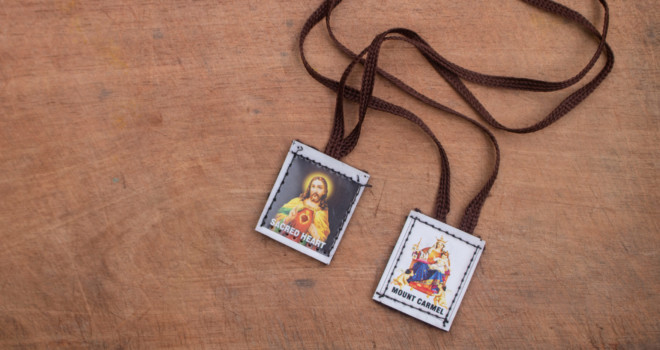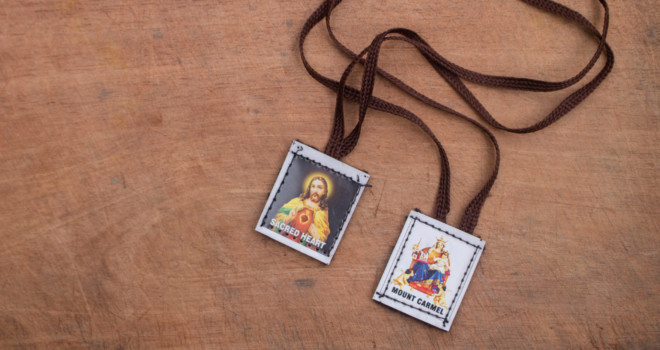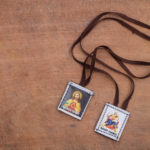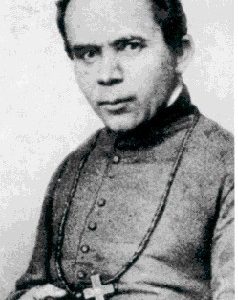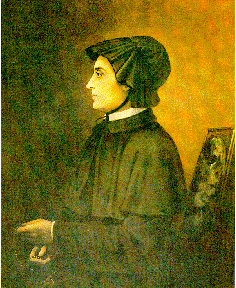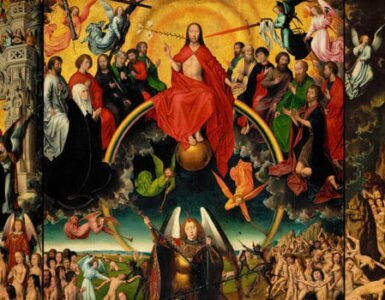July 16 was the Feast of Our Lady of Mount Carmel. Our Lady of Mount Carmel has been a source of rich devotional tradition throughout the centuries. For average pew-sitting Catholics, Our Lady of Mount Carmel is probably best known in connection with the brown scapular devotion. In this article we will learn a bit about the history of this devotion and how it came to occupy such a prominent place in the devotional life of Catholics the world over
First of all, what is a scapular? Scapular comes from the Latin word scapula, meaning “shoulder,” so called because it began as an over-garment suspended from the shoulders. While we may think of scapulars as small pieces of cloth, in the beginning they were full length garments, stretching the full length of the breast and reaching down almost to the feet in front and back. They were worn by monks over the habit (or soutane) and in time came to constitute the distinctive identification of a particular religious order. We need only think of the white-habited Cistercians with their characteristic black scapular, or the white scapular of the Dominicans to get a picture of how the monastic scapular complements with the religious habit.
How did the scapular shrink to becoming a small piece of cloth? The answer to this lies with the creation of Third Orders. Third Orders are associations of lay people living in secular society but under in association with a particular religious order and under their spiritual direction. The origin of Third Orders goes back to the Middle Ages; at that time, Third Order members typically wore the full monastic habit. By the end of the Middle Ages, however, this had begun to transform into wearing reduced versions of the habit that could be worn underneath everyday clothing. This necessitated the scapular being reduced in size; between the 17th century and today it gradually assumed the form it has today.
There are many types of scapulars, but the Scapular of Our Lady of Mount Carmel is the oldest. It dates to the 13th century and the life of the Englishman St. Simon Stock (1165-1265), who was the prior of the Carmelite Order. The Carmelite Order in the 13th century was in a time of transition. The Carmelites—at least in their current form—had begun in Palestine as an eremitic community centered on Mount Carmel during the crusades. But with the fall of the Crusader States to the Muslims in the 13th century, they began migrating into western Europe. These circumstances necessarily gave rise to many questions about the future of the order, how they would live, where, their manner of living, and so on. These were the matters St. Simon Stock found himself occupied with.
According to tradition, Our Lady appeared to St. Simon on July 16, 1251. She invested him with a brown scapular, implying a clothing with Mary’s graces and devotion to Christ. She said to him the words, “Hoc erit tibi et cunctis Carmelitis privilegium, in hoc habitu moriens salvabitur” (This shall be the privilege for you and for all the Carmelites, that anyone dying in this habit shall be saved). In the beginning, this privilege was taken to refer to those who wore the Carmelite habit—i.e., joined the Carmelite order. But, as was custom, the Carmelites gave their scapular to supporters and benefactors in the hopes that they, too, might receive some portion of the Virgin’s promises by virtue of their association with the order.
The brown scapular became extremely popular during the latter Middle Ages; throughout the 15th century a considerable amount of devotional literature appeared on the promises of the scapular, miracles associated with it, and tales of the visions and promises of the Virgin to St. Simon. Kings, nobles, and other notable people were eager to wear the scapular. By the Renaissance this devotion had become more formalized with the emergence of “scapular brotherhoods.” Members of these scapular brotherhoods most likely received the scapular with a formal investment ceremony, akin to what Catholics are familiar with today.
The popularity of this devotion caused it to be adopted by other orders: the Servites, Trinitarians, Mercedarians, Theatines, Franciscans, Dominicans, Benedictines, Congregation of the Precious Blood, Camillians, Augustinians, Lazarists, Passionists, and the Congregation of St. Michael the Archangel all have confraternities with associated scapulars. But the brown scapular of Our Lady of Mount Carmel remains the oldest and best known of all, worn to this day by millions of Catholics eager to partake of the graces promised by Our Lady to St. Simon Stock so long ago.


